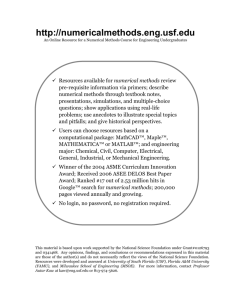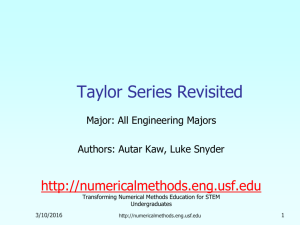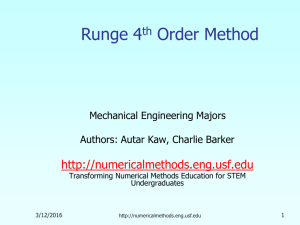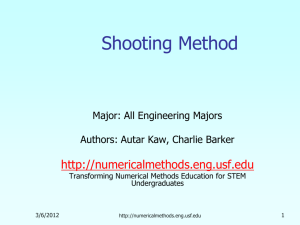Romberg Rule - Math For College
advertisement
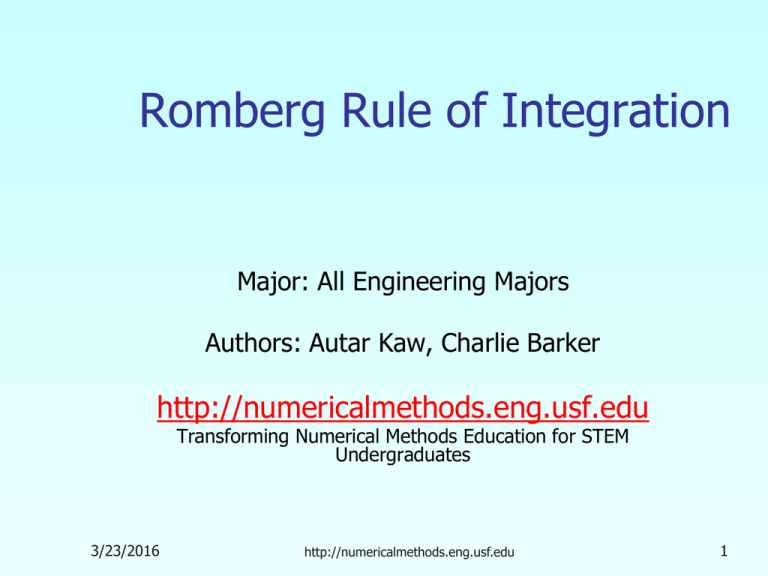
Romberg Rule of Integration Major: All Engineering Majors Authors: Autar Kaw, Charlie Barker http://numericalmethods.eng.usf.edu Transforming Numerical Methods Education for STEM Undergraduates 3/23/2016 http://numericalmethods.eng.usf.edu 1 Romberg Rule of Integration http://numericalmethods.eng.usf.edu Basis of Romberg Rule b Integration The process of measuring the area under a curve. f ( x )dx y a f(x) b I f ( x )dx a Where: f(x) is the integrand a= lower limit of integration b= upper limit of integration 3 a b x http://numericalmethods.eng.usf.edu What is The Romberg Rule? Romberg Integration is an extrapolation formula of the Trapezoidal Rule for integration. It provides a better approximation of the integral by reducing the True Error. 4 http://numericalmethods.eng.usf.edu Error in Multiple Segment Trapezoidal Rule The true error in a multiple segment Trapezoidal Rule with n segments for an integral b I f ( x )dx a Is given by n Et f i b a i 1 3 12n 2 n where for each i, i is a point somewhere in the domain , a i 1h , a ih . 5 http://numericalmethods.eng.usf.edu Error in Multiple Segment Trapezoidal Rule The term n f i can be viewed as an i 1 n approximate average value of f x in a ,b . This leads us to say that the true error, Et previously defined can be approximated as Et 6 1 n2 http://numericalmethods.eng.usf.edu Error in Multiple Segment Trapezoidal Rule Table 1 shows the results obtained for the integral using multiple segment Trapezoidal rule for 30 140000 x 2000 ln 9 . 8 t dt 140000 2100 t 8 n Value Et 1 11868 807 7.296 --- 2 11266 205 1.854 5.343 3 11153 91.4 0.8265 1.019 4 11113 51.5 0.4655 0.3594 5 11094 33.0 0.2981 0.1669 6 11084 22.9 0.2070 0.09082 7 11078 16.8 0.1521 0.05482 8 11074 12.9 0.1165 0.03560 t % a % Table 1: Multiple Segment Trapezoidal Rule Values 7 http://numericalmethods.eng.usf.edu Error in Multiple Segment Trapezoidal Rule The true error gets approximately quartered as the number of segments is doubled. This information is used to get a better approximation of the integral, and is the basis of Richardson’s extrapolation. 8 http://numericalmethods.eng.usf.edu Richardson’s Extrapolation for Trapezoidal Rule The true error, Et in the n-segment Trapezoidal rule is estimated as Et C n2 where C is an approximate constant of proportionality. Since Et TV I n Where TV = true value and I n = approx. value 9 http://numericalmethods.eng.usf.edu Richardson’s Extrapolation for Trapezoidal Rule From the previous development, it can be shown that C 2n 2 TV I 2 n when the segment size is doubled and that TV I 2 n I 2n I n 3 which is Richardson’s Extrapolation. 10 http://numericalmethods.eng.usf.edu Example 1 The vertical distance covered by a rocket from 8 to 30 seconds is given by 140000 x 2000 ln 9 . 8 t dt 140000 2100t 8 30 a) Use Richardson’s rule to find the distance covered. Use the 2-segment and 4-segment Trapezoidal rule results given in Table 1. b) Find the true error, Et for part (a). c) Find the absolute relative true error, a for part (a). 11 http://numericalmethods.eng.usf.edu Solution a) I 2 11266m I 4 11113m Using Richardson’s extrapolation formula for Trapezoidal rule TV I 2 n I 2n I n 3 TV I 4 I4 I2 3 and choosing n=2, 11113 11113 11266 3 11062m 12 http://numericalmethods.eng.usf.edu Solution (cont.) b) The exact value of the above integral is 140000 x 2000 ln 9 . 8 t dt 140000 2100t 8 30 11061 m Hence Et True Value Approximate Value 11061 11062 1 m 13 http://numericalmethods.eng.usf.edu Solution (cont.) c) The absolute relative true error t t would then be 11061 11062 100 11061 0.00904% Table 2 shows the Richardson’s extrapolation results using 1, 2, 4, 8 segments. Results are compared with those of Trapezoidal rule. 14 http://numericalmethods.eng.usf.edu Solution (cont.) Table 2: The values obtained using Richardson’s extrapolation formula for Trapezoidal rule for 30 140000 x 2000 ln 9 . 8 t dt 140000 2100 t 8 n Trapezoidal Rule 1 2 4 8 11868 11266 11113 11074 t for Trapezoidal Rule 7.296 1.854 0.4655 0.1165 Richardson’s Extrapolation -11065 11062 11061 t for Richardson’s Extrapolation -0.03616 0.009041 0.0000 Table 2: Richardson’s Extrapolation Values 15 http://numericalmethods.eng.usf.edu Romberg Integration Romberg integration is same as Richardson’s extrapolation formula as given previously. However, Romberg used a recursive algorithm for the extrapolation. Recall TV I 2 n I 2n I n 3 This can alternately be written as I 2n R I 2n 16 I 2n I n 3 I 2n I 2n I n 21 4 1 http://numericalmethods.eng.usf.edu Romberg Integration Note that the variable TV is replaced by I 2 n R as the value obtained using Richardson’s extrapolation formula. Note also that the sign is replaced by = sign. Hence the estimate of the true value now is TV I 2 n R Ch 4 Where Ch4 is an approximation of the true error. 17 http://numericalmethods.eng.usf.edu Romberg Integration Determine another integral value with further halving the step size (doubling the number of segments), I 4 n R I 4n I 4n I 2n 3 It follows from the two previous expressions that the true value TV can be written as TV I 4 n R I 4n 18 I 4n R I 2n R 15 I 4 n R I 2 n R 431 1 http://numericalmethods.eng.usf.edu Romberg Integration A general expression for Romberg integration can be written as I k , j I k 1, j 1 I k 1, j 1 I k 1, j 4 k 1 1 ,k 2 The index k represents the order of extrapolation. k=1 represents the values obtained from the regular Trapezoidal rule, k=2 represents values obtained using the true estimate as O(h2). The index j represents the more and less accurate estimate of the integral. 19 http://numericalmethods.eng.usf.edu Example 2 The vertical distance covered by a rocket from t 8 to t 30 seconds is given by 140000 x 2000 ln 9 . 8 t dt 140000 2100t 8 30 Use Romberg’s rule to find the distance covered. Use the 1, 2, 4, and 8-segment Trapezoidal rule results as given in the Table 1. 20 http://numericalmethods.eng.usf.edu Solution From Table 1, the needed values from original Trapezoidal rule are I 1,1 11868 I1,2 11266 I 1,3 11113 I1,4 11074 where the above four values correspond to using 1, 2, 4 and 8 segment Trapezoidal rule, respectively. 21 http://numericalmethods.eng.usf.edu Solution (cont.) To get the first order extrapolation values, I 2,1 I1, 2 I1, 2 I1,1 3 11266 11868 11266 3 11065 Similarly, I 2, 2 I1,3 I1,3 I1, 2 3 11113 11266 11113 3 11062 22 I 2,3 I1, 4 I1, 4 I1,3 3 11074 11113 11074 3 11061 http://numericalmethods.eng.usf.edu Solution (cont.) For the second order extrapolation values, I 3,1 I 2, 2 I 2, 2 I 2,1 15 11062 11065 11062 15 11062 Similarly, I 3, 2 I 2 , 3 I 2,3 I 2, 2 15 11061 11062 11061 15 11061 23 http://numericalmethods.eng.usf.edu Solution (cont.) For the third order extrapolation values, I 3,2 I 3,1 I 4 ,1 I 3,2 63 11061 11062 11061 63 11061m Table 3 shows these increased correct values in a tree graph. 24 http://numericalmethods.eng.usf.edu Solution (cont.) Table 3: Improved estimates of the integral value using Romberg Integration First Order 1-segment Second Order Third Order 11868 11065 2-segment 1126 11062 11062 4-segment 11113 11061 11061 11061 8-segment 25 11074 http://numericalmethods.eng.usf.edu Additional Resources For all resources on this topic such as digital audiovisual lectures, primers, textbook chapters, multiple-choice tests, worksheets in MATLAB, MATHEMATICA, MathCad and MAPLE, blogs, related physical problems, please visit http://numericalmethods.eng.usf.edu/topics/romberg_ method.html THE END http://numericalmethods.eng.usf.edu

